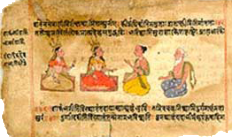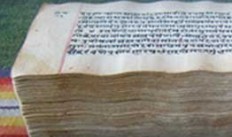THE COURSE DETAIL

The very name of the Veda explains its purpose–‘vedyate vastutattvamaneneti veda’ – that which explains the correct nature of a substance is called the Veda.
Vedas are the basic elements of the creation of universe. This revelation was made by Pandit Madhusudan Ojha of Jaipur in the last quarter of last century. Pandit Ojha presented the Vedas as science.
He revealed that whole universe is made of Vedas and Vedas exist in every small and big thing of the world. They are Rik, Yaju and Sama. Rik is Agni (Fire in abstract form), yaju is air and Sama, light. Fourth Veda is known as Atharva Veda. That is common in all three Vedas. It keeps every element in proper shape.
Vedas, Rik, Yaju and Sama are the real architect of universe and all its features like Sun, Moon and Earth. Rik, Yaju and Sama Vedas are Agni Vedas. Atharva Veda is Soma Veda. Interaction of Agni and Soma creates every thing. . Agni is ever expanding by nature and Soma is shrinking. Expanding and shrinking is the constant feature of our universe.
The Rik-Veda is known as Chhand Veda, Yaju is known as Rasa Veda and Sama is known as Vitan Veda. The Rik gives form to an object and Sama forms the radius of its visibility. Yaju is its soul. Every object is seen in different sizes from different places or distances.
2. What is Purusha
'Pure vasati iti purusah', viz. one that resides in Pura is Purusa. One that resides in full form (bhava) in the evidently visible body is called Purusa. In other words - one that resides in the vast space that exists in the body called brahmapura is Purusa.
In the Loka there are two Purusas – Ksara and Aksara. In the Gita Lord Krishna says—all aggregates of the gross material substances are Ksara Purusas. Hidden (kutastha) in them is Aksara Purusa which is supreme and distinct from others. It is called Avyaya Purusa. For the Uttam Purusa (the supreme spirit) the Lord says— ‘I am beyond Ksara and am superior to even Aksara. That is why in the Vedas, the Puranas and the world I have been described as Purusottama (supreme among Purusas).’ The Tattva called Avyaya Isvara, which permeates all the three Lokas and sustains them, has been described as Purusottama.
All the three Purusas—Avyaya, Aksara and Ksara have been identified by the name of a single Prajapati Purusa. Aksara Purusa permeates Avyaya Purusa in the same proportion as the latter pervades the universe or vice versa. No unit of Ksara Purusa ever exists without the support of Aksara Purusa, nor does Aksara Purusa ever exist without Avyaya Purusa. They (Avyaya, Aksara, Ksara) always remain entwined and inseparable. They nourish each other and manifest as independent objects.
Whatever is visible in this world becomes the subject of knowledge. There the all-pervading existence of the three Purusas is inevitable.

3. What is Maya

In Veda, Brahma has been described as Rasa and his inseparable and integrated Parasakti as Bala. The word ‘Para’ in ‘Parasakti’ has the same meaning as the word ‘Para’ in Parabrahma. This Bala (the power of Maya) is not considered different from Rasa, hence it does not contradict the principle of the non-duality of Brahma as propounded by the Veda. The dormant state of Maya is called Bala. When it is awakened in a state of a resolve to perform an activity, it is called sakti.
Rasa and Bala have the form of dharma. It means any substance made from Rasa and Bala in the form of dharma is called dharmavan or dharmi (endowed with dharma). These two dharmas in the form of Rasa and Bala are interwined and integrated, viz, one never lives without the other. They are the original dharma and all those produced in them are dharmi. The first dharmas Rasa and Bala are called dharma nirdharmak (bereft of dharmas) – the dharma that does not have any other dharma in it is called nirdharmaka.
The Rasa which becomes dharmi after it attains a distinctive transformation with the help of dharma in the form of Bala alone has been called Purusa. This eternal relationship of Rasa and Bala which acquires oneness or integral unity becomes imperishable forever. In other words, the Purusa permeated with Bala consisting of Rasa, becomes the regulator or modifier of the entire world. Therefore, the whole world has been described as comprised of Purusa.
Brahma is not Purusa. He is unbodied and bereft of Kala. Since Maya is dormant, there exists neither karma (activity) nor motion (outflow). With the awakening of Maya, a desire arises in Brahma - ekoham bahu syam – ‘I, one, may become many.’ But there isn’t any gati (motion) there. It is a form of Paratpara permeated with one disposition (Maya). As soon as Maya veils a part of Brahma and builds Pura, Brahma takes the form of Purusa. It is called the first Purusa of the creation – Avyaya Purusa. It alone becomes the prop or foundation of the entire creation.
4. What is Brahma
That alone is Brahma who is all-pervasive and who keeps expanding in all directions. It is called Brahma due to brhat (extensiveness), brmghana (expansion) and bharmana (sustaining and nurturing). The root bhr means sustenance and nourishment. “bhriyate jagat asmin” – that in whom exists the whole world is Brahm. One who holds or wields a thing is the Brahma of that thing. The earth (prthivi) is the Brahma of the earthly objects and the sun is the Brahma of the fiery or radiant objects. The basic Tattva which inheres in Prakat is the Brahma of the entire universe.
‘Brahma has two forms – Gyana (knowledge) and karma (action).’ Here the word ‘karma’ is a synonym of Maya (illusory power) or Bala. It can also be described as the synonym of nescience or ignorance. Maya (illusory power), karma (action), Bala (Maya), avidya (nescience or ignorance) and Mrtyu (death) are all synonyms. In principle Brahma is perfect in itself. karma too is complete in itself.
Brahma is bereft of activities. There is no kriya (functionality) there. For karma Maya alone does kriya in association with Brahma and thus creates the entire world. Brahma is not involved in it. Maya is an integral part of Brahma

